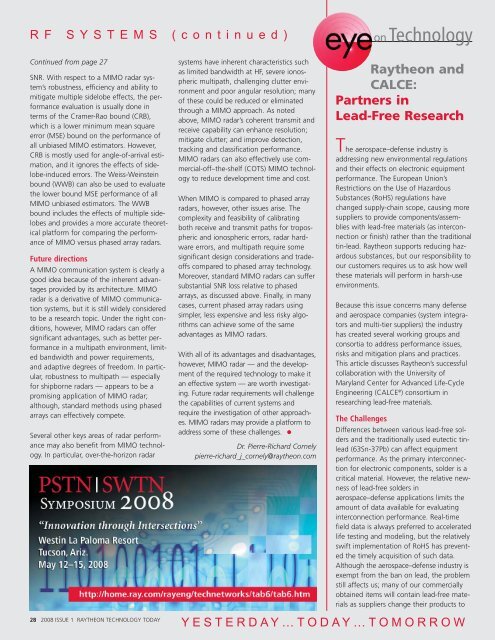Technology Today issue 1 2008 - Raytheon
Technology Today issue 1 2008 - Raytheon
Technology Today issue 1 2008 - Raytheon
Create successful ePaper yourself
Turn your PDF publications into a flip-book with our unique Google optimized e-Paper software.
RF SYSTEMS (continued)<br />
Continued from page 27<br />
SNR. With respect to a MIMO radar system’s<br />
robustness, efficiency and ability to<br />
mitigate multiple sidelobe effects, the performance<br />
evaluation is usually done in<br />
terms of the Cramer-Rao bound (CRB),<br />
which is a lower minimum mean square<br />
error (MSE) bound on the performance of<br />
all unbiased MIMO estimators. However,<br />
CRB is mostly used for angle-of-arrival estimation,<br />
and it ignores the effects of sidelobe-induced<br />
errors. The Weiss-Weinstein<br />
bound (WWB) can also be used to evaluate<br />
the lower bound MSE performance of all<br />
MIMO unbiased estimators. The WWB<br />
bound includes the effects of multiple sidelobes<br />
and provides a more accurate theoretical<br />
platform for comparing the performance<br />
of MIMO versus phased array radars.<br />
Future directions<br />
A MIMO communication system is clearly a<br />
good idea because of the inherent advantages<br />
provided by its architecture. MIMO<br />
radar is a derivative of MIMO communication<br />
systems, but it is still widely considered<br />
to be a research topic. Under the right conditions,<br />
however, MIMO radars can offer<br />
significant advantages, such as better performance<br />
in a multipath environment, limited<br />
bandwidth and power requirements,<br />
and adaptive degrees of freedom. In particular,<br />
robustness to multipath — especially<br />
for shipborne radars — appears to be a<br />
promising application of MIMO radar;<br />
although, standard methods using phased<br />
arrays can effectively compete.<br />
Several other keys areas of radar performance<br />
may also benefit from MIMO technology.<br />
In particular, over-the-horizon radar<br />
28 <strong>2008</strong> ISSUE 1 RAYTHEON TECHNOLOGY TODAY<br />
systems have inherent characteristics such<br />
as limited bandwidth at HF, severe ionospheric<br />
multipath, challenging clutter environment<br />
and poor angular resolution; many<br />
of these could be reduced or eliminated<br />
through a MIMO approach. As noted<br />
above, MIMO radar’s coherent transmit and<br />
receive capability can enhance resolution;<br />
mitigate clutter; and improve detection,<br />
tracking and classification performance.<br />
MIMO radars can also effectively use commercial-off–the-shelf<br />
(COTS) MIMO technology<br />
to reduce development time and cost.<br />
When MIMO is compared to phased array<br />
radars, however, other <strong>issue</strong>s arise. The<br />
complexity and feasibility of calibrating<br />
both receive and transmit paths for tropospheric<br />
and ionospheric errors, radar hardware<br />
errors, and multipath require some<br />
significant design considerations and tradeoffs<br />
compared to phased array technology.<br />
Moreover, standard MIMO radars can suffer<br />
substantial SNR loss relative to phased<br />
arrays, as discussed above. Finally, in many<br />
cases, current phased array radars using<br />
simpler, less expensive and less risky algorithms<br />
can achieve some of the same<br />
advantages as MIMO radars.<br />
With all of its advantages and disadvantages,<br />
however, MIMO radar — and the development<br />
of the required technology to make it<br />
an effective system — are worth investigating.<br />
Future radar requirements will challenge<br />
the capabilities of current systems and<br />
require the investigation of other approaches.<br />
MIMO radars may provide a platform to<br />
address some of these challenges.<br />
Dr. Pierre-Richard Cornely<br />
pierre-richard_j_cornely@raytheon.com<br />
on<strong>Technology</strong><br />
<strong>Raytheon</strong> and<br />
CALCE:<br />
Partners in<br />
Lead-Free Research<br />
The aerospace–defense industry is<br />
addressing new environmental regulations<br />
and their effects on electronic equipment<br />
performance. The European Union’s<br />
Restrictions on the Use of Hazardous<br />
Substances (RoHS) regulations have<br />
changed supply-chain scope, causing more<br />
suppliers to provide components/assemblies<br />
with lead-free materials (as interconnection<br />
or finish) rather than the traditional<br />
tin-lead. <strong>Raytheon</strong> supports reducing hazardous<br />
substances, but our responsibility to<br />
our customers requires us to ask how well<br />
these materials will perform in harsh-use<br />
environments.<br />
Because this <strong>issue</strong> concerns many defense<br />
and aerospace companies (system integrators<br />
and multi-tier suppliers) the industry<br />
has created several working groups and<br />
consortia to address performance <strong>issue</strong>s,<br />
risks and mitigation plans and practices.<br />
This article discusses <strong>Raytheon</strong>’s successful<br />
collaboration with the University of<br />
Maryland Center for Advanced Life-Cycle<br />
Engineering (CALCE ® ) consortium in<br />
researching lead-free materials.<br />
The Challenges<br />
Differences between various lead-free solders<br />
and the traditionally used eutectic tinlead<br />
(63Sn-37Pb) can affect equipment<br />
performance. As the primary interconnection<br />
for electronic components, solder is a<br />
critical material. However, the relative newness<br />
of lead-free solders in<br />
aerospace–defense applications limits the<br />
amount of data available for evaluating<br />
interconnection performance. Real-time<br />
field data is always preferred to accelerated<br />
life testing and modeling, but the relatively<br />
swift implementation of RoHS has prevented<br />
the timely acquisition of such data.<br />
Although the aerospace–defense industry is<br />
exempt from the ban on lead, the problem<br />
still affects us; many of our commercially<br />
obtained items will contain lead-free materials<br />
as suppliers change their products to<br />
YESTERDAY…TODAY…TOMORROW

















